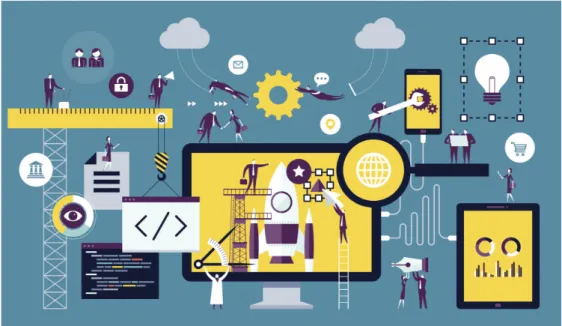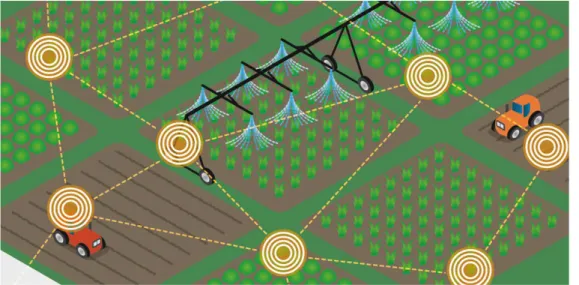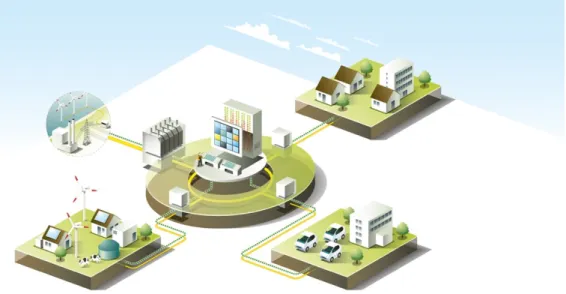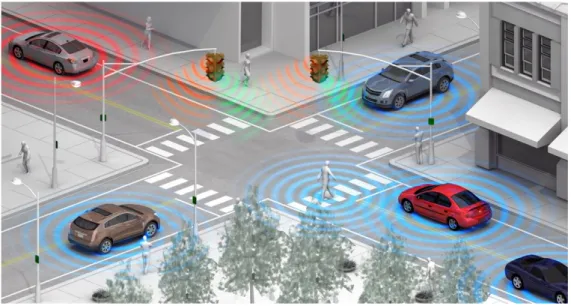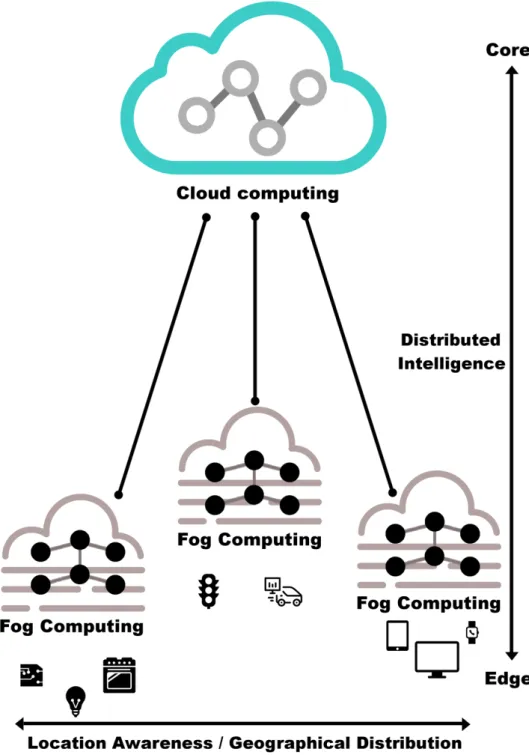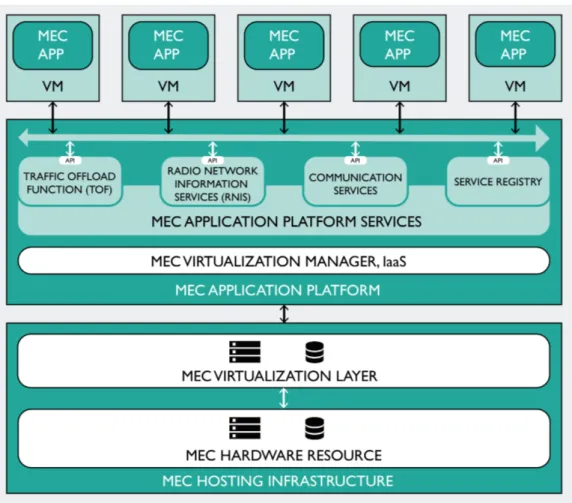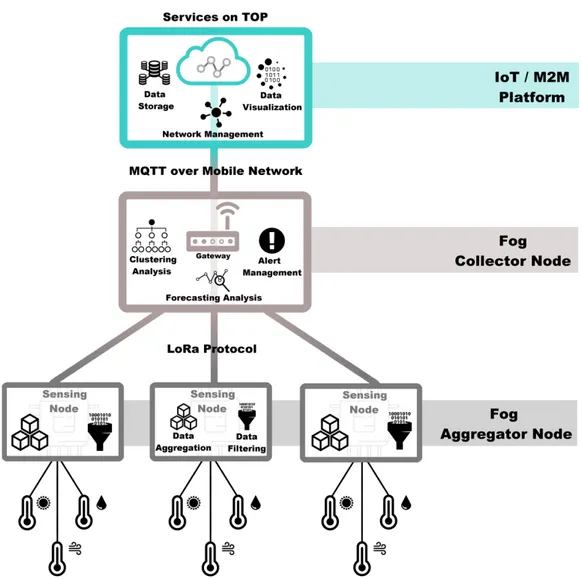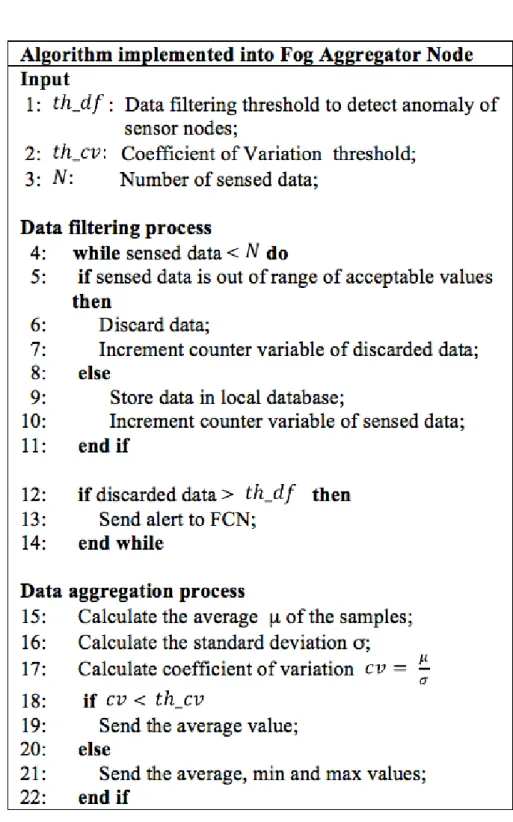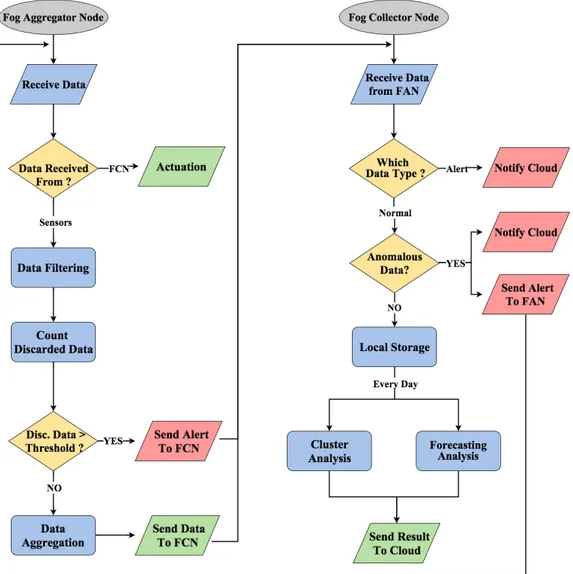UNIVERSITA’ DEGLI STUDI DI CATANIA
DOTTORATO IN INGEGNERIA DEI SISTEMI, ENERGETICA,
INFORMATICA E DELLE TELECOMUNICAZIONI
Edge Computing: challenges, solutions and
architectures arising from the integration of Cloud
Computing with Internet of Things
Ermanno Guardo
Coordinatore Tutor
Prof. Paolo Arena
Prof. Aurelio La Corte
Contents
1 Introduction ... 7
2 The fourth industrial revolution ... 11
2.1 Impact of IoT ... 11
2.2 IoT Segments ... 12 2.2.1 Smart City ... 12 2.2.2 Smart Agriculture ... 12 2.2.3 Smart Home ... 13 2.2.4 Smart Healthcare ... 14 2.2.5 Smart Grid ... 15
2.2.6 Smart Connected Car ... 16
2.2.7 Industry 4.0 ... 17
2.3 IoT communication protocols ... 19
2.3.1 MAC Protocols ... 20
2.3.2 Network and Transport Protocols ... 21
2.3.3 Application Protocols ... 23
2.4 Security in IoT ... 24
3 Moving Computation and Services to the edges ... 26
3.1 Literature Review ... 26
3.2 Fog Computing ... 27
3.2.1 Overview ... 27
3.2.2 Key features ... 31
3.2.3 Applications ... 31
3.3.2 MEC Architecture ... 35
3.3.3 Applications ... 40
4 Application and Proof of Concept Implementation ... 41
4.1 A Fog computing based architecture for precision agriculture ... 41
4.1.1 Scenario ... 41
4.1.2 Precision agriculture ... 43
4.1.3 The Fog-‐based framework ... 45
4.1.4 Simulation and evaluation of data traffic and data storage .... 54
4.1.5 Prototype ... 58
4.1.6 Discussion of results and possible developments ... 60
4.2 A Mobile Edge Computing solution for smart city services ... 61
4.2.1 Scenario ... 61
4.2.2 Proposed solution ... 62
4.2.3 Prototype operation ... 63
4.3 Proposed Architectures of MEC for critical event scenario ... 67
4.3.1 Scenario ... 67
4.3.2 Architecture and principle of operation of the solution ... 68
4.3.3 Discussion of results and possible developments ... 72
4.4 Proposed framework for mass events monitoring through crowdsourced media analysis ... 73
4.4.1 Scenario ... 73
4.4.2 Proposed Framework ... 75
4.4.3 Discussion of results and possible developments ... 79
5 Conclusion ... 80
List of Figures
Figure 1-‐ Infographic which represent the fourth industrial revolution ... 11
Figure 2 – Example of smart agriculture scenario ... 13
Figure 3 -‐ Major services in a smart home scenario ... 14
Figure 4 -‐ Example of Smart Grid Scenario ... 16
Figure 5 – Example of Smart Connected Car ... 17
Figure 6 -‐ Fog Computing scenario: the network has a distributed intelligence extended to the edge while the end devices present location awareness and geographical distribution. ... 30
Figure 7 – Example of smart street light ... 32
Figure 8 – MEC Server Architecture ... 38
Figure 9 -‐ Proposed framework in precision agriculture scenario exploiting the Fog Computing paradigm ... 46
Figure 10 -‐ Data filtering and Data aggregation process ... 51
Figure 11 -‐ Flow diagram which describes the Fog logic ... 54
Figure 12 -‐ Transmitted data (bytes-‐per-‐day) to the Cloud using the three different approaches represented in Log-‐10 scale. ... 57
Figure 13 -‐ Stored data (bytes-‐per-‐month) in the Cloud using the three different approaches represented in Log-‐10 scale. ... 58
Figure 14 -‐ Application prototype to manage agricultural lands: the field is divided into clusters grouped by soil moisture value ... 59
Figure 15 -‐ Application prototype to manage agricultural lands: alarm notification produced by sensor nodes. ... 60 Figure 16 – The operating principle that enable the smart street lighting
Figure 17 -‐ The operating principle that enable the smart street traffic light
service ... 66
Figure 18 – Developed prototype ... 66
Figure 19 -‐ Overall architecture of the proposed scenario ... 69
Figure 20 -‐ MEC Server software components ... 70
Figure 21 Flow diagram, which describe the MEC logic ... 72
Figure 22 – Proposed framework for Mass Event Monitoring ... 76
Figure 23 -‐ A flow diagram that describes the step-‐by-‐step interactions among the different modules of the proposed framework ... 79
Abstract
The rapid spread of the Internet of Things (IoT) is causing the exponential growth of objects connected to the network, in fact, according to estimates, in 2020 there will be about 3/4 devices per person totaling of over 20 billion connected devices. Therefore, the use of content that requires intensive bandwidth consumption is growing.
In order to meet these growing needs, the computing power and storage space are transferred to the network edge to reduce the network latency and increase the bandwidth availability.
Edge computing allows to approach high-‐bandwidth content and sensitive apps to the user or data source and is preferred to use it for many IoT applications respect to cloud computing. Its distributed approach addresses the needs of IoT and industrial IoT, as well as the immense amount of data generated by smart sensors and IoT devices, which would be costly and time-‐consuming to send to the cloud for processing and analysis. Edge computing reduces both the bandwidth needed and the communication among sensors and cloud, which can negatively affect the IoT performance.
The goal of edge computing is to improve efficiency and reduce the amount of data transported to the cloud for processing, analysis and storage.
The research activity carried out during the three years of the Ph.D. program focused on the study, design and development of architectures and prototypes based on the Edge Computing in various contexts such as smart cities and agriculture. Therefore, the well-‐known paradigms of Fog Computing and Mobile Edge Computing have been faced.
In this thesis, will be discussed the work carried out through the exploitation of the Fog Computing and Mobile Edge Computing paradigms, considered suitable solutions to address the challenges of the fourth industrial revolution.
1
Introduction
The concept of Cloud Computing has been evolving over the years since its introduction. Although it was introduced from the mainframe model, the Cloud Computing concept expanded from ’60 and ’70 including not only a processors sharing, but also other concepts and technologies.
In 1961, John McCarthy at MIT’s centennial celebration stated that “Computing may someday be organized as a public utility just as the telephone system is a public utility”, thus imagining a future where Computing could have been distributed and organized on different systems of public access [1].
Cloud Computing regards both applications delivered as services over the Internet, and the hardware and software systems in the data center that provide those services [2].
The benefits of Cloud Computing have been discussed since a long time, but now we are witnessing the fourth industrial revolution related to the Internet of Things (IoT), the era in which “things” tend to gain more and more intelligence, becoming smart and being able to communicate with other “things”, integrating several technologies and communications solutions [3].
IoT is a remarkable transformation of the way in which our world is interacting [4]. Much like the World Wide Web connected computers to networks, and the next evolution connected people to the Internet and to other people, the IoT can interconnect devices, people, environments, virtual objects, machines and internet services with the goals of reducing the complexity of creating opportunities for a closer integration of the physical world with computer-‐based systems and developing efficient solutions for smart city services. Developing smart city services [5] such as transportation, parking, lighting, traffic, waste and safety requires the availability of a platform which permits speeding up and reducing the implementation costs of the services themselves, providing new capabilities for automation, analysis at multiple levels, greater scalability and virtualization.
Therefore, the IoT paradigm is the key towards this revolution improving service levels and as a consequence the customer satisfaction, and meeting the demand of a new generation of empowered customers with smart products. IoT modeling constitutes a global network of interconnected and uniquely addressable “things”, merging various heterogeneous communication technologies, both wired and wireless [6].
IoT will not be seen as individual system, but as a critical, integrated infrastructure upon which many applications and services can run [7].
The extended use of heterogeneous sensors, involves a new challenge to extract useful information from a complex sensing environment [8]. Internet of Things is leading the research to investigate and develop novel and high-‐ performance computing architectures due to large amount of data analysis produced. Cloud Computing provides a solution to support dynamic
scalability in many vertical areas such as smart city [9], [10], [11], smart home [12], smart agriculture [13], healthcare [14] [15], smart grid and several context-‐aware environment of Wireless Sensor Networks (WSNs) [16]. However, the deployment of a large number of devices and sensors for IoT requires location awareness and low latency, which, currently, are missing in commercial Cloud Computing models. One of the main challenges of IoT is related to increasing amount of devices connected to the network which is going to further grow [17], [18].
Therefore, Cloud Computing must be able in the near future to manage this large amount of data from the network that will probably lead to the reduction of available bandwidth and the subsequent increase of latency. IoT, along with actual and future challenges of Cloud Computing, claims for novel frameworks and paradigms, able to face the ubiquitous and pervasive nature of networks and the data-‐intensive Computing requirements [19].
To overcome this hurdle, has been conceived the edge computing paradigms such as Fog Computing [20] and Mobile Edge Computing (MEC) [22].
Strictly linked to IoT, the Fog Computing broadens the Cloud, extending some services also to the edge of network with the aim to transfer a part of processing at the edge of the network, close to the users and the field devices.
Thus, Fog Computing founded as a highly virtualized platform and applicable in many IoT scenarios, moves the processing abilities closer to the data source, proving useful to the smart grid, realizing more rapid M2M (Machine-‐ to-‐Machine) communications, and even in the smart city context, shifting the decisions near the place where data are collected [20]. Therefore, in order to
avoid a high exploitation of the Cloud resources, Fog Computing applications and services, allow interaction between Cloud and Fog, in particular when it comes to data management and analytics [21].
Whereas the Fog Computing is focused about edge computing concept with a more general point of view and can be designed on different layers of the network architecture, the MEC instead is more specific and consists of assigning computing capability to the RAN (Radio Access Network) in such a way to make a pre-‐processing of data from users/things which are within the range of the specific BTS (Base Transceiver Station) providing rapid deployment of applications and other customer services. The main idea behind Mobile Edge Computing is to reduce network congestion and improve applications by performing related processing tasks closer to the end user. MEC can be implemented both indoors and outside depending on the access technology. With respect to the outdoors, macro cells place computing and virtualization capabilities into radio network elements.
In this thesis, various edge computing solutions (architectures and applications) will be discussed covering different contexts such as smart city, agriculture, and critical event management.
The proposed solutions concern both Fog Computing and Mobile Edge Computing paradigms.
The thesis is organized as follows: at the beginning it is explained the fourth industrial revolution highlighting the impact of the IoT in the main scenarios in which it is spreading and the protocols used. Chapter 3 discusses the edge computing paradigm focused on fog computing and mobile edge computing.
Chapter 4 discusses on the work carried out. Finally, Chapter 5 concludes with some considerations and discussions of future work.
2
The fourth industrial revolution
2.1 Impact of IoT
The IoT represents the new evolutionary stage of the Internet: no more people, but things, connect and interact through the network, improving the ability to collect, analyze and distribute convertible data into information. So new scenarios are opened for businesses and for people.
IoT already has impact on our daily lives. It will continue to generate significant and broad ranging impact across all sectors making life easier and smarter which confirms the view that the IoT has a wide variety of meanings, and that its impact will vary across different companies and industry sectors.
2.2 IoT Segments
2.2.1 Smart City
Smart city spans through a wide range of use cases, e.g. traffic management, water distribution, waste management, urban security, environmental monitoring, etc. Its popularity is fueled by the fact that many Smart city solutions promise to alleviate real pains of people living in cities these days and improve QoL (Quality of Life). IoT solutions in the area of Smart city solve traffic congestion problems,
reduce noise and pollution and help make cities safer. According to World Health Organization (WHO), “The global urban population is expected to grow by approximately 1.84 percent per year between 2015 and 2020 and by 1.63 percent per year between 2020 and 2025” [23]. Considering these alarming figures -‐ both in terms of urban overpopulation and rural under population, there is a need to build smarter cities that can accommodate traffic smartly by reducing traffic congestion and air pollution efficiently. IoT will enable smooth flow of traffic in busy cities, allowing you to spend quality time with your family, rather than on the road and most importantly, decreasing the number of fatalities every year. This could be achieved by leveraging analyzed data for real-‐time solution and advanced communication systems using next generation technologies.
2.2.2 Smart Agriculture
Agricultural IoT will completely subvert the traditional assertions that “physical world” and “ICT world” are separated. In agricultural IoT, farmland,
agricultural machineries, and fresh agricultural products are integrated with the chips, broadband network and database systems, forming a completely new “agricultural infrastructure”. IOT applications in agriculture include food traceability (RFID), soil and plant monitoring, precision agriculture, greenhouse environment monitoring and control systems, monitoring of food supply chain, monitoring of animals, etc.
Figure 2 – Example of smart agriculture scenario
2.2.3 Smart Home
Smart homes are the next big thing driven by IoT. Imagine your home equipped with smart things, like home appliances, refrigerators and washing machines that can send alerts based on the situation and requirement. Air conditioners and heaters are synchronized with electronic sensors to minimize consumption of energy, providing environmental benefits. Also, smart homes will be built for elderly care to monitor their health and call for
help, as and when required. Thus, giving the elderly chance to stay longer in their own home and environment.
Figure 3 -‐ Major services in a smart home scenario
2.2.4 Smart Healthcare
Internet -‐ connected devices are steadily being introduced in the healthcare sector in various forms and segments. Using the IoT concept to the area will make it possible to realize instant and continuous monitoring, monitoring and remote adjustments and treatment, etc. in cases such as breathing patterns, temperature, blood pressure, physical position and balance. These innovative IoT -‐ based wearable devices are helping users minimize healthcare challenges, thus offering a better quality of life (QoL). For example, AliveCor [24] wireless heart monitor allows patients to monitor and manage their cardiac conditions. These services will create continuous revenue through consumption or subscription fees for continuous data analysis. Also, creating an opportunity for smarter devices to deliver valuable data, while reducing
the need for direct patient -‐ doctor interaction. The impact of IoT on healthcare will be very high. It will revitalize better and faster treatment, shorter and better recovery, improved QoL, and longer stay in own home, safety, cost savings, maintaining healthcare plans , keeping citizens fit , more efficient treatment, less hospital beds and places in elder centers, less hospitalization and cost savings in reduced consultations and shorter use of recovery equipment.
2.2.5 Smart Grid
To realize the full potential of Smart Energy, major changes in the energy system, specially at the lower network level, will require integration of smart houses in the smart grid. IoT will play a vital role in streamlining the transfer of high volumes of data over IP. IoT connected devices will establish communication between context -‐ aware sensors and smart meters at user sites, allowing devices to be switched off based on load patterns. Smart grid technology is helping businesses and consumers cut their energy usage while advancing an intelligent, resilient and self -‐ balancing utility network by enabling utilities to wirelessly connect to circuit breakers and meters. Real -‐ time data from smart meters is also helping utilities monitor use and tackle energy efficiency. A smart grid is mostly about balance and efficiency while optimally delivering energy at the lowest cost and highest quality. For instance, Pacific Gas and Electric installed smart meters that help to cut the duration of power outages, improve operations by seeing energy consumption on one dashboard. The last shows where energy demands will surge enabling them to redistribute energy accordingly. Customers can now
track their energy usage using a website that is in -‐ sync with the smart meter sitting outside their home.
Figure 4 -‐ Example of Smart Grid Scenario
2.2.6 Smart Connected Car
IoT enabled cars are coming slowly and steadily due to the fact that the automotive industry takes 2 -‐ 4 years. These cars of the future will be very different from the cars of today. Connected, automated vehicles will communicate among themselves and / or to Infrastructure through Vehicle -‐ to -‐ Vehicle (V2V) and Vehicle -‐ to -‐ Infrastructure (V2I) technology and will reform road safety and reduce accidents. Connected devices have made autopilot (vehicle without hands on control) and auto parking a reality. Audi and Tesla have embedded “Google Street View” in their navigation system,
helping the user to know the traffic conditions ahead. The technology gives the user options to choose a different route and therefore reduce traffic.
Figure 5 – Example of Smart Connected Car
2.2.7 Industry 4.0
IoT is poised for rapid growth across a wide variety of industries that will connect the physical and the digital world. Participation of major blue chip and networking companies, such as IBM, Intel, Qualcomm, ARM and Cisco, in the IoT technologies is a key validation of its business potential to become a multi-‐trillion-‐dollar market. Social networking giant, Facebook is moving towards IoT connectivity by supplying a developer kit for Parse -‐ Facebook backend platform, which will enable developers to create IoT-‐enabled apps to support companies such as Intel and Broadcom. This kit also enables users
with ease in order to accelerate the delivery of new IoT services at low cost to the market without the Capital Expenditure (CAPEX) and Operating Expense (OPEX) overhead of an IoT backend platform.
In 2016, Atmel Corporation [25] introduced an automated beer-‐brewing machine titled ‘Artbrew’ that helps to solve a problem that has challenged craft beer makers for many years. The machine starts brewing automatically with a touch of a button and depending on your choice of beer, it takes one to three weeks to mesh, filter and ferment. The unit uses smart sensor technologies and its app to update the user on the status of the process. This smart technology makes the brewing process accurate and stable, giving the user the most consistent taste. IoT has made operations smarter in multiple ways; businesses have integrated IoT-‐based technology into their processes to work efficiently. GE is using numerous sensors to measure temperature, air pressure and operational data in real time in their battery plant in New York. This helps the company to monitor their production and processes in real time and also track battery performance. The benefits are higher product quality (less faulty battery), command premium pricing in the market, more production volume per plant, improved employee productivity and a greater customer satisfaction. Major chip companies and networking companies have taken one step forward by investing heavily in IoT. In 2015, companies are investing in cloud, data centers and big data analytics, IBM had announced an investment of $3 billion over the next four years into a separate IoT division. Cisco acquired Jasper Wireless for $1.4 billion, a market leader with a cellular connectivity software platform and also acquired a cloud security company ‘Open DNS’ for $635 million to enhance its position in
the IoT market [26]. IoT has also transformed the healthcare industry by providing increased efficiency, lower costs and enhanced patient care. IoT is the driver for revolutionizing patient care as quoted in the latest report by Mind Commerce entitled “Big Data in IoT” it is stated that ‘The use of IoT is expected to grow fastest in healthcare over the next few years, to the tune of $117 billion by 2020’ [27]. Through connected devices, one can capture real-‐ time data and analyze it, thus helping healthcare providers maintain compliance and conduct research for enhanced patient care. IoT is being adopted across industries, such as transportation and logistics (T&L). The sector is increasingly using smart devices to capture and share data to enable greater visibility and understanding of the logistics of transportation. Companies can now pinpoint where trucks are at any moment in time, what delivery has been made and locate missing or late vehicles in emergency situations. A recent Forrester [28] study reveals that 96 percent of T&L companies agree that the IoT is the most strategic technological initiative their organization will undertake this decade. Security sensors, Wi-‐Fi and real-‐time locating systems are the technologies that will help drive the global adoption.
2.3 IoT communication protocols
This section analyzes the main protocols used for IoT at different levels of the network, especially at the MAC, Network, Transport, and Application layer.
2.3.1 MAC Protocols
An IoT application must specify how the various objects are interconnected starting from the bottom of the TCP/IP Stack.
The most used MAC protocols for the IoT are 802.15.4 [29], WiFi [30] and Bluetooth Low Energy [31].
IEEE 802.15.4 is the most widespread protocol for Wireless Sensor Networks (WSN). In 802.15.4 the nodes connect to a coordinator in a star, tree or mesh topology. The coordinator might be application specific or provide Internet connectivity to the nodes.
Estimating application latency in 802.15.4 networks is application specific, because the packets to be received are polled by the nodes at specific intervals. As most nodes are battery-‐operated, they might sleep for hours before turning on the radio again. However, the latency for sending such message is in the order of 2.4 ms and 6.02 ms, plus any retransmission needed in case of errors.
In [32], the authors have measured that low-‐power Wi-‐Fi (LP-‐WiFi) provides a significant improvement over typical Wi-‐Fi on both latency and energy consumption counts. According to the authors, LP-‐Wifi consumes approximately the same power as 802.15.4 for small packets but it performs better for large packets. Thus, it is possible that a LP-‐Wifi approach will emerge as a solution in some sensor network applications.
Since its first version, Bluetooth has been used to control from cars to wristbands and in general most of our personal devices. Bluetooth imposes a star topology to networked things, placing the user-‐controlled device as the center. Bluetooth has a very short range, and it is suitable for Personal Area
Network devices. As an example, Bluetooth is used for headsets, speakers, printers, and quantified self devices.
Low Bluetooth Energy (BLE) offers a low power alternative to the standard Bluetooth, reducing latency to 6ms and application throughput to 236.7 kbit/s [33]. However, it reduces the power consumption while connected to 0.024 mA, giving an expected battery life of 1 year over a coin battery. BLE chips are cheaper than 802.15.4 chip, but it requires more processing power.
2.3.2 Network and Transport Protocols
The network and transport layers of any Internet of Things applications are extremely important to achieve interoperability between different solutions. On one hand, the user is always connected through the Internet stack, which right now involve the Internet Protocol (IPv4) [34] as network protocol and the Transmission Control Protocol (TCP) [35] as transport protocol. On the other hand, the things might be connected through different protocols, such as ZigBee.
At the network level, the major issue of IPv4 is its byte address field length, which is only 32 bits. As of today, all the possible addresses are allocated. Therefore, the next version of the Internet Protocol, called IPv6, uses 128 bits for its address field, which allows plenty of addresses for all the possible things. However, IPv6 headers are much larger than IPv4, and the IPv6 over Low power Wireless Personal Area Networks (6LoWPAN) standard specifies how to compress them to fit in a 802.15.4 frame.
The TCP creates a communication channel between two remote parties, a client and a server. TCP is the basis of the World Wide Web, as it creates a
reliable communication channel between the parties by involving retransmissions. In [4], the authors discuss the reasons why TCP is not sufficient as a transport protocol for the IoT: connection setup, congestion setup, and data buffering makes TCP expensive to send end-‐to-‐end messages on battery-‐powered devices that are in a sleeping state. Thus, TCP cannot be used on sensors that have an estimated battery lifetime of years.
The User Datagram Protocol (UDP) [36] offers the minimum set of features for a transport protocol: application multiplexing, via port numbers, and integrity verification, via checksum, of the header and payload. The main difference with TCP is that UDP is not reliable: the application is responsible for handling the retransmissions of lost messages. Thus, IoT applications can customize the trade-‐off between reliability, congestion control, and battery consumption.
ZigBee is a network, and application protocol suite that aims to solve the industry and home automation problem. Thus, it is not compatible with the Internet stack, and requires a gateway. ZigBee uses 802.15.4 as its MAC layer, thus it supports start, tree, and mesh topologies. At the network level, ZigBee supports network routing through the Ad hoc on-‐demand distance vector (AODV) routing algorithm [37].
The ZigBee standard includes no transport layer, but it have several application profiles that specifies the functionalities of the things: these profiles dictates the available data across different vendors.
2.3.3 Application Protocols
At the application layer, thing-‐driven approaches leverage binary protocols and data formats that are specifically designed for machine to machine communications. These protocols and data format introduce little overhead, minimize battery consumption but are usually not reused in other fields. The benchmark against which all these protocols should measure is HTTP, as it is extremely familiar to the developers.
The most widespread open protocols specifically designed for the IoT are MQTT [38] and the Constrained Application Protocol (CoAP) [39], which are based on TCP and UDP, respectively. MQTT is a classical publish/subscribe protocol, while CoAP is a request/response protocol based on the REST pattern. Both MQTT and CoAP support the same primitives: MQTT focuses on sending and receiving updates, while sup-‐ porting basic syndication; CoAP focuses on syndication, while supporting a basic notification mechanism. Hypertext Transfer Protocol (HTTP) [40] is the basis of the Web, and it is used also to integrate different software applications using the Representational State Transfer pattern [41], where every resource is globally identified by an Uniform Resource Identifier (URI). As of today thousands of businesses offer REST APIs for creating new applications. It is also important to note that HTTP is a text-‐based protocol with many data types being transferred in text format. HTTP is designed to support caching and several approaches exist to syndicate data.
The MQTT protocol is fast, lightweight, power efficient and implements various levels of Quality of Service (QoS). MQTT is based on TCP, so it provides standard TCP delivery reliability, in addition to its own QoS
mechanism. MQTT implements a classic publish/subscribe (pub-‐ /sub) pattern with a central broker. The protocol revolves around the concept of topic, where clients might publish updates or subscribe to for receiving the updates from other clients. The MQTT community claims that a pub/sub protocol is what is needed to build a true IoT. MQTT can also tunneled over a Web Socket, thus allowing web client to communicate with the nodes with extremely low latency.
The Constrained Application Protocol (CoAP) is an implementation of the Representational State Transfer pattern (REST) and it is similar in HTTP from a high-‐level point of view. However, it is implemented over UDP and it is binary. Thus, it significantly reduces the overhead for battery-‐powered devices while guaranteeing HTTP compatibility through a proxy. CoAP supports a basic notification mechanism, the observe option, which is similar to the HTTP Server-‐Sent Events.
2.4 Security in IoT
Due to the global connectivity and sensitivity of applications, security in real deployments in the IoT is a fundamental requirement.
Following are some security services needed for the IoT:
Confidentiality: Messages that flow between a source and a destination could be easily intercepted by an attacker and secret contents are revealed. Therefore, these messages should be hidden from the intermediate entities; in other words, End-‐to-‐End (E2E) message secrecy is required in the IoT. Also,
the stored data inside an IoT device should be hidden from unauthorized entities. Confidentiality services ensure this through encryption/decryption. Data Integrity: No intermediary between a source and a destination should be able to undetectably change secret contents of messages, for example a medical data of a patient. Also, stored data should not be undetectably modified. Message Integrity Codes (MIC) are mostly used to provide this service.
Source Integrity or Authentication: Communicating end points should be able to verify the identities of each other to ensure that they are communicating with the entities who they claim to be. Different authentication schemes exist.
Availability: For smooth working of the IoT and access to data whenever needed, it is also important that services that applications offer should be al-‐ ways available and work properly. In other words, intrusions and malicious activities should be detected. Intrusion Detection Systems (IDSs) and firewalls, in addition to the security mechanisms above, are used to ensure availability security services.
Replay Protection: Last but not least, a compromised intermediate node can store a data packet and replay it at later stage. The replayed packet can contain a typical sensor reading (e.g. a temperature reading) or a paid service request. It is therefore important that there should be mechanisms to detect duplicate or replayed messages. Replay protection or freshness security services provide this, which can be achieved through integrity-‐protected timestamps, sequence numbers, etc.
3
Moving Computation and Services to the edges
3.1 Literature Review
The first concept of edge computing dates back to the 1990s, with the introduction of content delivery network (CDNs) by Akamai to accelerate web performance [42]. A CDN uses nodes at the edge close to end users to perform prefetching and caching techniques for the web content.
In 2012, Flavio Bonomi et. al presented one of the first works on Fog Computing assessing the suitability for the IoT. [20]. In this work the author presents the requirements of emerging applications in terms of location awareness, real time interactions and need for geo-‐distributed end-‐points and how Fog Computing addresses these issues. Furthermore, they provide further insight into the suitability of Fog Commuting for IoT applications with a few use-‐cases including a smart traffic light system and a smart wind farm in the following paper [21].
MEC aims at reducing network stress by shifting computational efforts from the Internet to the mobile edge.
The MEC concept has mainly been discussed from a non-‐ technical perspective by IBM which discusses economical benefits for businesses and M2M applications [43] and Nokia Networks which introduce a first real-‐world MEC platform [44]. In this approach, MEC servers are standard IT equipment with processing and storage capacity directly placed at mobile network’s base
stations, which are capable of collecting real-‐ time network data like cell congestion, subscriber locations, and movement directions.
The most important advantage of edge computing inside cellular networks is given by a reduction of end-‐to-‐end delay. Moreover, storing only relevant information for the coverage of a single cell implies a reduction in computational overhead since many tasks can be performed on smaller data sets.
There are some related approaches that are similar to the MEC concept. Therefore, Mobile Cloud Computing (MCC) is highly related to mobile edge computing. In [45] is presented a survey on Mobile Cloud Computing describing cloud-‐affine mobile application types. The Cloudlets are an example of MCC [46] .
The main features of Cloudlets are: resource wealth, fast and stable Internet access and provide computing, bandwidth, and storage resources to nearby mobile users.
While cloudlets are owned and managed by mobile end users, MEC servers are operated by mobile infrastructure provider. Being co-‐located with base stations, MEC servers provide additional features such as being able to access position and mobility information.
3.2 Fog Computing
3.2.1 Overview
As defined in [47], Cloud Computing can be thought as an aggregation of Computing, providing on demand network access to computing, configurable
and shared resources, which can be rapidly supplied and released with minimal management effort or service provider interaction. A key requirement for a Cloud provider is the virtualization of resources in order to allow the required scalability of the Cloud, giving the users a perception of infinite resources [48], providing high storage capacity, high flexibility and high-‐computing performance [49].
Today we are going to the fourth industrial revolution related to the Internet of Things that consists of having an increasing amount of objects connected to the Internet with their own IP address, to exchange useful data to be processed and analyzed.
However, the transmission of all these data to the Cloud might be inefficient because of requiring high processing capacity and bandwidth, increasing the latencies and consequently negatively affecting the performance of the entire network and even leading technologies such as optical fiber or 4G connectivity having limitations caused by the cost of traffic and availability of bandwidth.
To support the Cloud, by a meteorological metaphor, originates “Fog Computing”, an innovative paradigm which is an extension of the Cloud with the basic idea to transfer a part of processing to the edge of network, close to the end-‐users in order to solve some problems related to Internet of Things, e.g. the availability of bandwidth and the network’s latencies.
Whereas Cloud Computing is based on large data centers away from the user, the Fog promises to bring more processing power in the network edge [21]. This is even more important for the devices themselves or local gateways, reducing the amount of data to be transmitted to the Cloud, allowing a highly
virtualized platform in order to provide processing, analysis, storage, and networking services between end devices and data centers, other than supporting large-‐scale of sensor networks [20].
In Fog Computing paradigm any irrelevant information is filtered and discarded, whereas the most important ones are forwarded. One of the main goals of Fog Computing is to exploit the available resource of the end devices to allow the network to have a better-‐distributed intelligence and enhance the performance.
In [50] Fog Computing is defined as “a scenario where a huge number of heterogeneous (wireless and sometimes autonomous) ubiquitous and decentralized devices communicate and potentially cooperate among them and with the network to perform storage and processing tasks without the intervention of third-‐parties. These tasks can be for supporting basic network functions or new services and applications that run in a sandboxed environment.
3.2.2 Key features
The main features of Fog Computing are:
Location awareness and low latency capabilities: this feature is crucial to
support endpoints with rich services to the edge of network including application with low latency requirements.
Geographical distribution: Unlike the centralized Cloud the services and
applications deployed in the Fog are widely distributed among several geographic positions.
Support for mobility: Many application need to communicate directly with
the mobile devices and the Fog allows to decouple host identity from location identity through mobility techniques such as the LISP protocol [51].
Heterogeneity of resources: Fog nodes come in different form factors, and
will be deployed in a wide variety of environments.
Interoperability and federation: In order to support services (such as
streaming) the cooperation of different providers is required. Hence, Fog components must be able to interoperate, and services must be federated across domains.
3.2.3 Applications
Fog Computing brings many benefits in various IoT scenarios such as:
Connected Cars: Fog computing is the ideal for the connected vehicles (CV)
because real time interactions will make communication between cars, access points and traffic lights as safe and efficient as possible. Video camera that senses an ambulance flashing lights can automatically change street
lights to open lanes for the vehicle to pass through traffic. Smart street lights interact locally with sensors and detect presence of pedestrian and bikers, and measure the distance and speed of approaching vehicles. As shown in Figure 7, intelligent lighting turns on once a sensor identifies movement and switches off as traffic passes. Neighboring smart lights serving as Fog devices coordinate to create green traffic wave and send warning signals to approaching vehicles. Wireless access points like Wi-‐Fi, 3G, road-‐side units and smart traffic lights are deployed along the roads. Vehicles-‐to-‐Vehicle, vehicle to access points, and access points to access points interactions enrich the application of this scenario [52] [53].
Smart Grids: Fog computing allow fast, machine to machine (M2M)
handshakes and human to machine interactions (HMI) which would work in cooperation with the cloud. Energy load balancing applications may run on network edge devices, such as smart meters and micro-‐grids Based on energy demand, availability and the lowest price, these devices automatically switch to alternative energies like solar and wind. As shown in Figure 4, Fog collectors at the edge process the data generated by grid sensors and devices, and issue control commands to the actuators. They also filter the data to be consumed locally, and send the rest to the higher tiers for visualization, real-‐time reports and transactional analytics. Fog supports ephemeral storage at the lowest tier to semi-‐permanent storage at the highest tier. Global coverage is provided by the Cloud with business intelligence analytics [54].
Wireless Sensor and Actuator Networks: Traditional wireless sensor
networks fall short in applications that go beyond sensing and tracking, but require actuators to exert physical actions like opening, closing or even carrying sensors. In this scenario, actuators serving as Fog devices can control the measurement process itself, the stability and the oscillatory behaviors by creating a closed-‐loop system. For example, in the scenario of self-‐ maintaining trains, sensor monitoring on a train’s ball-‐bearing can detect heat levels, allowing applications to send an automatic alert to the train operator to stop the train at next station for emergency maintenance and avoid potential derailment. In lifesaving air vents scenario, sensors on vents
